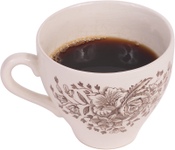|
|
Welcome to the first monthly installment of BrandingWire. For the first month, we are using a fictitious local coffee shop chain as a case study. If you are or know of a company that would like the posse at BrandingWire to tackle a challenge, let one of us know. Your idea may get chosen for a future BrandingWire feature!
 The challenge (in a nutshell):
The challenge (in a nutshell):
Small, family owned coffee company in mid-America. They have a few retail stores, roast their own beans on site, kind of country-funky décor. They’ve got a strong local following but nothing beyond that geography, in terms of business awareness and/or traffic. They’re reasonably profitable and have good cash flow.
They have a bad name and bad tagline (great coffee at great prices!) and no distinctive visual pieces/brand.
They want to grow but are not sure how/in what direction. Competition is closing in.
My response:
It’s incredibly tempting to simply prescribe a solution. That’s one of the biggest dangers facing marketing professionals. It’s very seductive to just make one of the following assumptions at the outset:
We are the audience – "I hang out at a coffee shop so I must be just like their customers."
We know who the audience is – "I get the coffee shop people. They’re all yuppies who want…"
This is just like another project we worked on – "when we did the re-branding for the salad dressings, we…"
Are there kernels of truth in all the statements above? Most likely, yes. But do we know enough to make sweeping recommendations? Nope. And if we do, we’re going to get it wrong. Even if we’re partially right.
So where do we go from here?
Really, this is three very different challenges:
Branding – how should this coffee shop differentiate themselves from their competition?
Marketing – how should they spread the word, increase traffic and demand for their products/services?
Growth Strategy – in what directions (more stores, customer loyalty/ambassador clubs, online sales of coffee beans, adding food/catering, coffee tasting – like wine tastings, coffee region tours etc) should the store owners take the business to create sustainable growth?
Just from a manageability point of view, I am only going to address the first of the three, because I’d like to go deep, rather than scratch the surface of all three. And I suspect this is already going to be my longest post of all time! Normally I’d break this up into a series, but…bear with me and the length. Hopefully it will be worth it.
I wrestled with how to approach this branding challenge for quite a bit. I could make some assumptions (even sharing what they are) and propose a solution. But that’s not how my agency or my brain works. And I don’t think the readers of this blog (and the BrandingWire site) will gain as much from my guesses as they will from an abbreviated version of what we’d really do if a prospect like this walked in the door.
Just a quick refresher from my post a couple weeks ago.
A brand is a unified, singular understanding of what an organization is about and how it is unique from the key audiences’ points of view. In English – it’s why a potential client or employee would choose you over your competitor. What makes you stand out from the rest? What’s it like to do business with you? How do they experience you?
It is you standing up, hand on heart and making a promise. And then keeping that promise.
A brand is like a three-legged stool. The three legs are:
1. The company’s vision of the brand
2. The consumers’ vision of the brand
3. Where your brand sits in the marketplace
At MMG, we help a client discover their brand so they can create a love affair with their customers. To do that, we ask questions. Lots of questions. (Naturally, I’m only going to scratch the surface but you’ll get the idea.)
So let’s identify some questions that will help the coffee shop hone in on all three legs of their stool. Keep in mind we engage a client’s internal branding team in 20-25 hours of questions, exercises and exploration to help them discover their brand. But, this is a good sampling.
We’d ask the coffee shop owners to form an internal branding team that would work with us throughout the process. The branding team must include everyone at the C-level and then a member from each department or area of the shop. So it might be a bean roaster, a clerk, a barista, a bean buyer, etc. The key is to have all aspects of the shop represented. From the coffee shop owner’s POV:
From the coffee shop owner’s POV:
Of all the businesses you could have started, you chose the coffee shop business. Why? What appealed to you? Is it what still appeals to you?
If you closed your business today, what "hole" would be left in your marketplace? What wouldn’t people be able to get/do?
Do you help your customers do or achieve or get something that they wouldn’t be able to accomplish without your help?
Make a list of 2-3 core reasons for being. Why you exist and what unique role you play in the marketplace. (Don’t be surprised or frustrated if you can’t answer this. Most often it needs to be discovered.)
What kinds of promises do you already make to your customers? Are they related to:
- Pricing
- How you’ll deliver your product/services
- Product (quality, quantity, variety etc.)
- Environment (what the shop/experience is like)
- Something else?
What do you hope every customers walks out knowing/feeling?
What are 3-5 things your customers have asked for/if you did in the past 6 months? (i.e. coffee tasting events – like wine tasting events)
If money/time were no object – how would you change/add to the customer experience in your current shops? What do you wish you could do different?
What three things are you most proud of, in terms of your business?
If your business were a person, how would you describe its personality? Give us five different adjectives. (Serious? Warm? Informed? Etc.)
The ideal way to find these answers is t o spend time interviewing the coffee shop’s customers, one by one. This interview technique is preferable if you are looking for qualitative data – impressions, feelings, reactions, preferences, frustrations etc.
We’d ask for a cross section of customers, both in terms of frequency of visits and demo/psychographics. What we’re looking for are trends and recurring themes.
Where did you go to get coffee before going to the client’s coffee shop?
Why did you switch?
What did you expect (both good and bad) the first time you walked into the coffee shop? Did they meet those expectations?
How often do you visit the coffee shop?
When you are there, do you go in? Drive thru? How long do you stay?
What do you do when you’re there? Are you usually there alone?
What do you love (and yes…that’s the word we’d use) most about the coffee shop?
What do you tolerate because you love the place?
Do you consider the coffee shop "your" coffee shop?
If you owned the shop, what would you do differently? What new products/services would you offer? What would you take away or stop doing?
What five words would you use to describe this coffee shop?
If the shop were ten miles further away, would you still be a customer?
If someone moved into your neighborhood and asked you about local merchants, would you tell them about this store?
If someone had never visited the store and asked you about it – what would you say?
 The marketplace that impacts the coffee shop:
The marketplace that impacts the coffee shop:
This is about two different aspects of the marketplace. First…who else is out there and what is their claim to fame? How do they brand themselves and how well do they do it? Keep in mind that competitors not only include other coffee shops but other places people gather, other places people buy drinks etc. The competition that most people forget is the choice to do nothing. To make coffee at home.
The second aspect of this focus is to answer the question — what’s not there? Think of the marketplace as a topographical map. Any brand position successfully occupied by a competitor is raised on the map. Where are the flat spots? What needs are not being met? Here’s the toughest question – what need that hasn’t yet been identified as a need, is not being met?
We can gather much of this information through observation. Visit the competitors and do some secret shopping. Check out websites. Clip ads.
Surveying the marketplace is a powerful and quantitative balance to these observations. Be sure that your questions measure not only how the competitors position themselves in the marketplace but if the consumers buy the positioning. Just because they say it, doesn’t mean their actions confirm it. In other words, I can tell you that I’m a duck. But, you may not believe it. My actions and choices might suggest I am more of a penguin and you probably see me as that way.
Letting the answers be your answer
By asking all of the questions and sorting and sifting through the answers, the brand reveals itself. It will reflect the coffee shop owner’s heart and soul. It will represent something the employees and customers recognize and know is authentic and true because they’ve experienced it, even if they couldn’t describe or identify it before. It will be something that the marketplace is hungry for, whether they know it or not.
And from that sold foundation, the marketing and growth strategies can build.
BrandingWire is a collaborative of high-voltage marketing experts with a wide variety of branding, marketing, PR and communications skills. The pundits of BrandingWire not only maintain individual content-loaded blogs, but also have banded together to collaboratively offer perspectives and commentary on a variety of branding themes.
Each month, we focus our creative bandwidth on a particular branding challenge or topic, and collectively give our perspectives on how we’d apply best branding practices. So tune in, early each month, for the newest jolt from the BrandingWire team! Contrast and compare our responses to this month’s branding challenge.
The posse:



![Reblog this post [with Zemanta]](http://img.zemanta.com/reblog_e.png?x-id=11c9c390-cff0-43ca-a61b-0ea1fa6143f5)